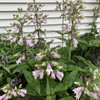

Please note your preferred ship date/week in the "Order Comments" section at checkout.
Otherwise, please allow 1-3 weeks to receive your order.
See the "Shipping" page under "Company Information" for our default ship dates based on hardiness zone.
We are unable to ship to any US Territories, AK, AZ, CA, CO, HI, ID, MT, NM, NV, OR, UT, WA, or WY
Strictly upright woodland beardtongue. Never flopping, it boasts thick rosettes of basal leaves and long stems with tubular pink-purple flowers (sometimes white-pink).
There aren't many woodland Penstemons, so this one brings a nice extension of the genus. It's a great perennial, even if it only flowers for about 3 weeks; it's still a valuable plant and an unfortunately underused wildflower despite its beautiful structure. Somewhat similar to Penstemon digitalis (Foxglove Beardtongue), but tolerates much more shade and less drought.
Can grow in full sun (with constant moisture), but prefers some shading or dappled shade. It makes a nice addition to half-shaded woodland edges, half-shade borders, wildlife gardens, pollinator gardens, hummingbird gardens, low maintenance plantings or half shaded prairies (savannas).
Good perennial combinations can be with these natives : Aquilegia canadensis, woodland Asters (A. cordifolius, A. macrophyllus, A. divaricatus, A. ciliolatus), Carex, Eupatorium coelestinum, Geranium maculatum, Heuchera, Iris cristata, Mertensia virginiana, Monarda bradburiana, Polemonium reptans, Silene virginiana, Solidago caesia, Solidago amplexicaulis etc.
From non native perennials, choose Aquilegia vulgaris, Brunnera, Carex oshimensis, Carex x morrowii, Hakonechloa, Hemerocallis (botanical species), Hosta, Epimedium, Iris sibirica, Ligularia, Omphalodes, Waldsteinia, etc.
Blooming Time: June/July
Size: 4’ tall x 0.7’ wide
USDA Zones: 5 to 8
Culture: full sun, half sun, dappled shade. Average soil, rich loamy soil, woodland soil, improved clayish soil (with compost and other organic material).
Moisture Needs: medium, medium-moist
Origin: native wildflower found in the eastern USA, grows naturally on open woodland rocky slopes, woodlands, woodland borders, oak savannas. Can be found in high quality and disturbed areas.
Deer/Rabbit Resistant: yes / yes
Attracts Butterflies or Pollinators: offer nectar for long-tongued bees like honeybees, bumblebees, Anthophorine bees, digger bees, mason bees, and leaf-cutting bees, which seek nectar primarily. Occasional visitors can be Halictid bees and Sphinx moths. Host plant for caterpillars of the Chalcedony Midget Moth.
Attracts Hummingbirds: yes, but they are not frequent visitors
Pot Size: 3.5" x 4" perennial pot (1.22 pt/580 ml)
Strictly upright woodland beardtongue. Never flopping, it boasts thick rosettes of basal leaves and long stems with tubular pink-purple flowers (sometimes white-pink).
There aren't many woodland Penstemons, so this one brings a nice extension of the genus. It's a great perennial, even if it only flowers for about 3 weeks; it's still a valuable plant and an unfortunately underused wildflower despite its beautiful structure. Somewhat similar to Penstemon digitalis (Foxglove Beardtongue), but tolerates much more shade and less drought.
Can grow in full sun (with constant moisture), but prefers some shading or dappled shade. It makes a nice addition to half-shaded woodland edges, half-shade borders, wildlife gardens, pollinator gardens, hummingbird gardens, low maintenance plantings or half shaded prairies (savannas).
Good perennial combinations can be with these natives : Aquilegia canadensis, woodland Asters (A. cordifolius, A. macrophyllus, A. divaricatus, A. ciliolatus), Carex, Eupatorium coelestinum, Geranium maculatum, Heuchera, Iris cristata, Mertensia virginiana, Monarda bradburiana, Polemonium reptans, Silene virginiana, Solidago caesia, Solidago amplexicaulis etc.
From non native perennials, choose Aquilegia vulgaris, Brunnera, Carex oshimensis, Carex x morrowii, Hakonechloa, Hemerocallis (botanical species), Hosta, Epimedium, Iris sibirica, Ligularia, Omphalodes, Waldsteinia, etc.
Blooming Time: June/July
Size: 4’ tall x 0.7’ wide
USDA Zones: 5 to 8
Culture: full sun, half sun, dappled shade. Average soil, rich loamy soil, woodland soil, improved clayish soil (with compost and other organic material).
Moisture Needs: medium, medium-moist
Origin: native wildflower found in the eastern USA, grows naturally on open woodland rocky slopes, woodlands, woodland borders, oak savannas. Can be found in high quality and disturbed areas.
Deer/Rabbit Resistant: yes / yes
Attracts Butterflies or Pollinators: offer nectar for long-tongued bees like honeybees, bumblebees, Anthophorine bees, digger bees, mason bees, and leaf-cutting bees, which seek nectar primarily. Occasional visitors can be Halictid bees and Sphinx moths. Host plant for caterpillars of the Chalcedony Midget Moth.
Attracts Hummingbirds: yes, but they are not frequent visitors
Pot Size: 3.5" x 4" perennial pot (1.22 pt/580 ml)
I have hairy penstemon thriving in a sunny spot. I'm excited to try a variety for shade. I'll report back next summer on how it grows.
It was in great shape when I picked it up, it is growing nicely in my woodland garden
